When a built-in drain-pipe, a sewer pipe or a Y-branch breaks down, repair work involves demolishing walls and sometimes wall coverings and floors, causing evident inconvenience, especially when the work is carried out inside the building. Here is a wide review of non- destructive repair techniques for internal pipes in buildings.
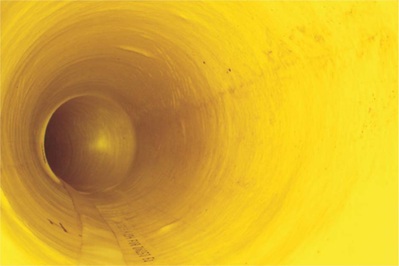
Many years ago the concept of repairing underground pipes in urban infrastructures (sewers, aqueducts, gas networks etc) led to the creation of rehabilitative no-dig technologies. This same no-dig idea, transferred to buildings, results in non-destructive rehabilitative technologies, or more simply, non-destructive repair technologies for internal pipes in buildings. The real differences between the two techniques are the distinguishing feature of internal size, almost always smaller in the internal pipes of buildings (diameter less than 150-200mm), the high number of special parts used ("T", "Y") and the often very accentuated curves (45° or 90°). Fig. 1 - Complex pipeline systems needing repair are present in many buildings.Downpipes, sewer pipes or Y- branch can be repaired or made as new again without the need to demolish walls, coverings or floors. Repair can be carried out rapidly, without troubling the inhabitants and very often at a cost far below that of traditional techniques. For example, in the case of a classical built-in downpipe 125mm in diameter and 21 meters long (a six floor building), total repair using traditional methods would involve:
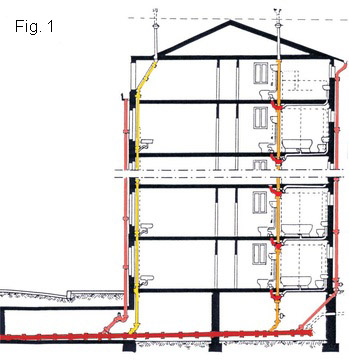
A - Breaking the whole wall area and any tiles or other covering present, for a width of about 30 cms; B - Removing the old pipe and making the new one function; C - Replacing the wall, covering and all the fixtures previously in place.
If the whole work is carried out from the inside of the building, demolition will inevitably cause inconvenience from dust, noise and the temporary non- availability of the rooms involved. If, on the other hand, all is done from the outside, a scaffolding will be required of the appropriate height, which will remain on the site for the entire duration of the work, very likely not less than 5-7 working days.Furthermore, setting up a scaffolding means occupying public ground, and of course involves seeing that the scaffolding is safe, also in view of burglary risks. The result is an overall cost which can vary from 5,500 to 8,000 Euro and more, with a unitary price ranging from 260 to 380 Euro per meter. These figures can vary according to the differing characteristics of the building, and whether work is done from inside or outside the construction.
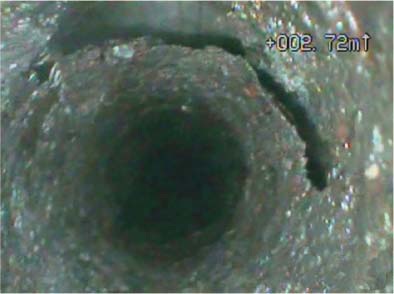
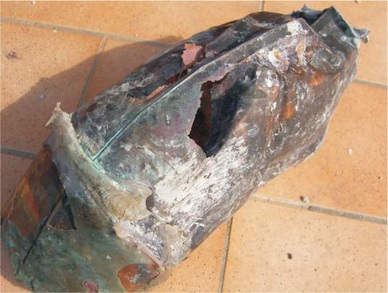
Under the same conditions, non-destructive repair of the same downpipe would not only cost considerably less (about 200 Euro per linear meter – equal to from 25% to 40% less), but could be done in a single day, without any need for scaffolding, without disrupting the rooms involved, and especially without demolition. Therefore no dust, no noise and no inconvenience for people. These elements are equally valid for the internal vertical sewer conduits of the buildings sewer plant, and even for the whole vertical sewer/Y- branches system.
Repair of downpipes and sewer pipes
We will now take you through a non-destructive repair job. This basically means constructing a new pipe on the site, following the well-tried Cured in Place Pipe method (CIPP). The new pipe adheres to the inner walls of the old one and, once built, is able to carry out all the hydraulic, mechanical and chemical resistant functions of the original. To do this, the new pipe comes to the site in the form of a flexible liner, made of extremely light polyester felt or fabric, coated with a plastic layer (PU) on the outer surface, and internally impregnated with epoxy resin or other material, according to its end use. The liner can be easily inserted into the old pipe (host pipe), being very flexible when the resin is still fluid. During insertion the resin impregnated liner surface must be on the outside (touching the inner walls of the old pipe being repaired), the so-called inversion procedure is initiated, while at the same time the liner is expanded inside the old pipe. To effect inversion, a compact air instrument called "inversion drum" is used. This tool is simply a spiral shaped airtight chamber, into which is inserted the previously resin impregnated liner. When the liner, because of the pressurized air, is gradually expelled through the inversion drum mouth, it turns, while exiting, inside the host pipe, swelling with air, thanks to the way in which the free end of the liner is linked to the inversion drum mouth. While keeping the inversion drum pressurized, the whole liner is turned and expelled until it is completely inserted into the old pipe.
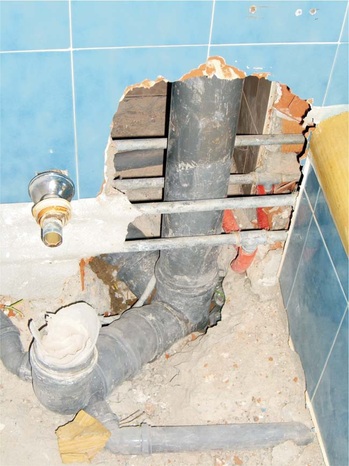
To effect inversion, a compact air instrument called "inversion drum" is used. This tool is simply a spiral shaped airtight chamber, into which is inserted the previously resin impregnated liner. When the liner, because of the pressurized air, is gradually expelled through the inversion drum mouth, it turns, while exiting, inside the host pipe, swelling with air, thanks to the way in which the free end of the liner is linked to the inversion drum mouth. While keeping the inversion drum pressurized, the whole liner is turned and expelled until it is completely inserted into the old pipe. The entire operation only takes some tens of minutes, as the expansion and consequent advance of the liner proceed at a speed of about 2-4 meters a minute. When insertion finished, after a space of time ranging from 0,5 to 1,5 hours, according to the resin characteristics the resin will begin to harden without causing any harmful emissions. Within 0,5 to 4 hours (varying from thermal to ambient curing resins) the resin reaches complete polymerization, and the flexible liner becomes a new rigid pipe, just a few millimetres thick (from 3 to 6, according to the conditions of the host pipe), geometrically adherent to the host pipe walls, perfectly water proof and both mechanically and chemically resistant.
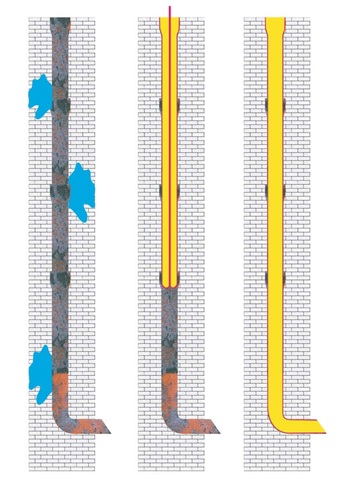
With these techniques the old pipe, probably suffering from holes and even considerable cracks, now becomes basically a mere mould, and at the end of the repair job any and all holes or damage will be perfectly sealed. Particularly in the case of downpipes and sewer pipes, where the host pipe has curves, even of up to 90%, these are followed exactly by the liner during the insertion phase, thanks to its great flexibility. Where, instead, special parts are present (such as "Y" or "T" parts) the liner comes with various arms, so that it can follow with geometrical exactitude the old, multi-armed duct, though the insertion operation is slightly more complex. In fact it was due to this special technique that the Grandi Stazioni Spa Company was able to use non- destructive methods to repair the "Y" shaped downpipes of the great Central Station of Milan, Italy. This work, carried out by the Italian firm IN.TEC of Segrate (since 1992 this company holds the patent rights for this specific technique) has to date permitted the non-destructive repair of about four kilometres of downpipes, without the hundreds of thousands of passengers who use this railway station being aware that work of such magnitude was being carried on. All work in fact was done from the roof of the station, and no pre-existing pipes were demolished.
This same technique of liners which envisage up to two arms on the same duct, can be used for repairing, in one sole operation, the vertical sewer which present up to two Y-branches of as many sanitary systems.
A similar operation can be carried out, once the vertical sewer has been repaired, by reopening and then repairing the Y-branches with spot Y-shaped tailored liners. As the old pipe now functions simply as a mould, undergoing no external changes nor tampering of any kind, this technique is eminently suitable for repairing downpipes placed on the outside of a building.
This is usually the case with historic buildings whose downpipes, though damaged, possess a certain architectural or historic value worthy of preservation.
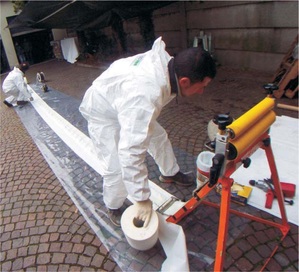
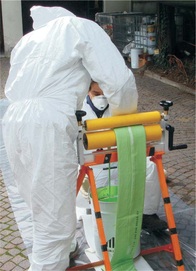
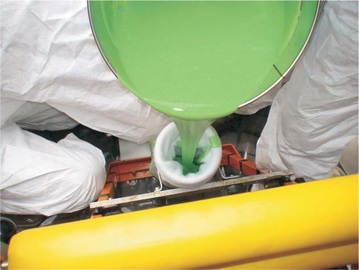
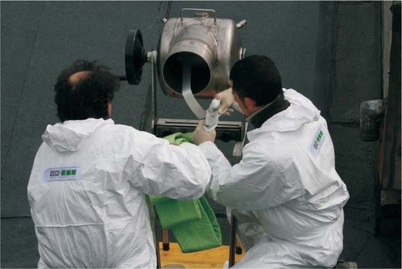
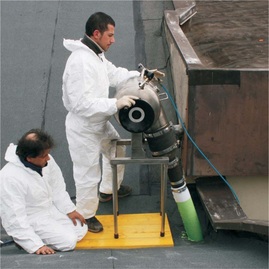
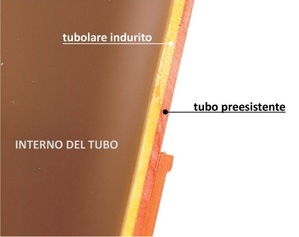
It also holds for those cases where it is preferred to avoid scaffolding. Furthermore, non- destructive repair may be considered justified in order to avoid tampering with facing or decorations existing on the inner walls of the rooms, whenever these may be of particular value. We could mention hundreds of examples of this kind carried out in Europe over the last 15 years.
However, this technique is used daily by now for repairing downpipes and sewer pipes in ordinary buildings, even though it certainly is much more widespread out of Italy.
All the operations described up to now must obviously be carried out after a scrupulous visual check with the help of micro TV-cameras with remote control (CCTV). Sometimes it is necessary to recourse to specific laser tools to get the internal measurements of the old pipe. A preliminary and thorough cleaning of the latter must be effected to eliminate any scale, occlusions and sector shrinking so as to provide, in the end, a new pipe with characteristics often better than those of the old one. With regard to the duration of this type of pipeline, not less than 50 years is that indicated by the current regulations, such as for example the UNI EN 13566-4:2005, or the ASTM 1216:2008, which are applied for repairing the ducts of urban systems (sewers, aqueducts, gas).
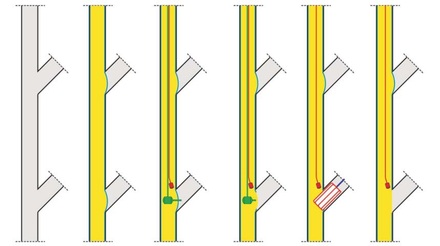
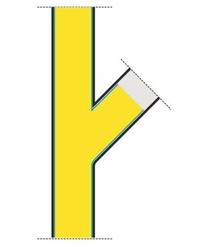
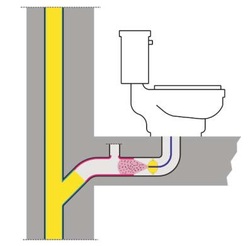
Long term sanitization of air- conditioning ducts
For the air-conditioning ducts of public buildings (shops, banks, hospitals, public offices, schools, supermarkets etc) as well as those of work activities in general (private offices, work-shops etc), there also exist non-destructive techniques, aimed more at sanitize them out from an antibacterial and anti- fungous point of view than at their rehabilitation.
It must also be said that the approach to this type of problem has been up to now almost exclusively one of cleaning procedures. This involves removing by brushing, and subsequent aspiring, the dust deposited in the aeraulic ducts, a disinfectant then being applied. Such interventions give results of short duration. By antibacterial and anti-fungi interventions, instead, are meant treatments of long term efficacy (form 5 to 10 years)
In air-conditioning ducts there tend to form potentially dangerous fungi (such as aspergillus) and colonies of pathogenic bacteria, (such as legionella) which can be breathed in by humans through air flow, spore and bacteria. This can cause a considerable increase in the risk of diseases such as aspergillosis or legionellosis. Long term sanitizing air-conditioning ducts is a fundamental sanitary requirement for preventing serious illnesses, particularly in places where the presence of officials and employees is constant (banks, public offices, schools etc). This treatment should be carried out every ten years, or better, every five years. Even more dangerous is the problem of fungi and bacteria in air-conditioning ducts in hospitals, as the people most exposed (those recovered there) almost always suffer from low level resistance in their immune systems due to the illnesses which have forced them there.
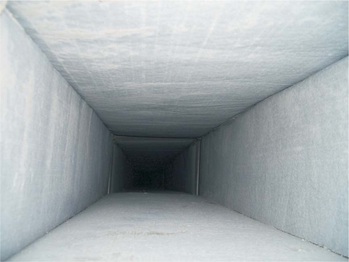
It is therefore no coincidence that this technique has been experimented over the last 10 years, particularly in hospitals, so as to reduce the mortality rate linked to the illnesses caused by the fungi and bacteria present in the air- conditioning ducts. The long term sanitization treatment consists in a technique called coating, involving the spraying by means of a remote controlled system inside the duct, of a specially conceived resin, enriched by an antibacterial and anti-fungi agent. This agent, continuing to remain encased in the resin, prevents the return of pathogenic agents over the following years.
The resin is capable to encapsulate both dust and microorganisms, and crumbled insulations. It is not harmful for workers and users. Antibacterial coating is the name given to this non-destructive technique for long term sensitization of air-conditioning ducts. As has been demonstrated in large Italian hospitals (such as the San Raffaele of Milan or the Sant'Orsola of Brescia, to name but a few), the special formulation of the fungi-bacteria destroying resin has lead to an antibacterial and anti-fungi effect which, as official documents show, continues to be effective in these ducts even after 10 years. They are still completely devoid of any pathogenic bacteria or fungi. As with downpipes and sewer pipes, all the operations here described are carried out without demolition, work being done from the service grates or any accesses already present to the air- conditioning ducts. The effectiveness of the anti- bacteria coating as compared to traditional cleansing techniques is linked to the fact that the liner of fungi/bacteria- destroying resin, used in anti-bacteria coating, adheres to the pipeline walls, blocking the development of fungi and bacteria over a long lapse of time exactly where these pathogenous agents find easy ground for development – the walls of the duct. With traditional methods, on the contrary, any substance, even if in the form of aerosol, simply dispersed into the air-flow and transported by same, for hydrodynamic reasons deposits very scarcely on duct walls, especially in the straight stretches, and concentrates instead on the bends and mouths. Which explains why certain treatments are effective only in the short run. Worthy of note is the fact that this technology is once more Italian, having been patented once more in 1997 by IN.TEC of Segrate (Milan)
The overall view offered in this report presents a very innovative picture in the field of rehabilitating pipes inside buildings. Such work to date was burdensome and costly, but today the current rehabilitating technologies have effectively overcome these problems. As from now, therefore, and thanks to these techniques, having to break walls to repair a pipe inside a building will become less and less necessary and advantageous.
All rights reserved - © 2009-2013